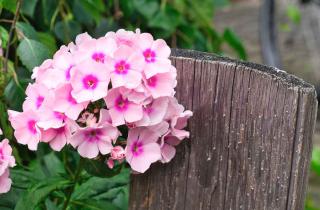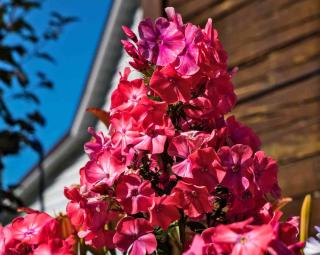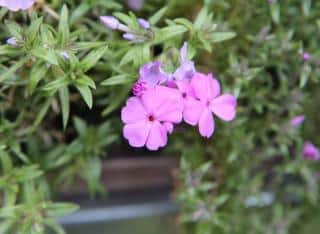

Phlox is among the very beautiful flowers that decorate our gardens over the summer.
Short Phlox facts
Name – Phlox
Family – Polemoniaceae
Type – perennial or annual
Height – 8 inches to 3 feet (0.2 to 1 m)
Exposure – full sun
Soil – rather rich and well drained
Flowering – April to October
Foliage – semi-evergreen
Easy to care for and grow, they’ll charm you because they’re are extremely ornamental.
 Phlox is a perennial flower that is quite hardy. It appreciates rather rich and humus-containing soil, but will still grow fine in ordinary earth.
Phlox is a perennial flower that is quite hardy. It appreciates rather rich and humus-containing soil, but will still grow fine in ordinary earth.
There are also annual phlox species, one of which is called Drummond’s phlox, which only bloom in summer.
Sowing annual phlox is easy and quick, and is best done directly in the garden.
Just as for annual phlox, it appreciates rather rich soil.
 Most phlox varieties do great in containers. They don’t specifically need deep soil, a normal pot that’s as deep as it is wide will do great.
Most phlox varieties do great in containers. They don’t specifically need deep soil, a normal pot that’s as deep as it is wide will do great.
Terra cotta tends to dry out fast, but it’s also better at keeping the soil cool. If you can water regularly, this is the option to go for. If you might miss watering for a few days in a row during hot weather, better go for a plastic or an enameled pot.
Perennial phlox is easily propagated through crown division.
 Whether you’re dealing with annual or perennial phlox, care is quite easy and usually boils down to watering when the soil is dry.
Whether you’re dealing with annual or perennial phlox, care is quite easy and usually boils down to watering when the soil is dry.
More regular watering is required for phlox growing in pots, garden boxes or container.
The most famous annual Phlox is Phlox drummondii.
There are a great many phlox varieties and species, but they all have one thing in common: they love sun!
Perennial phlox will grow back year after year but it is best, right after the first frost spells, to cut the foliage short. It would quickly turn black if left on the plant. Protect with a fair layer of dead leaf mulch.
You can pull out annual phlox because they don’t grow back from one year to the next.
Very easy-growing plants, Phlox only need to be watered in dry and hot weather.
This plant presents abundant and plentiful blooming for the most part of the year.
The Phlox genus comprises a great diversity of plants. Herbaceous, annual and perennial versions of the plant exist.
 Over 60 phlox species have been numbered to date. A few famous varieties like the annual Drummond phlox and the perennial ‘Orange perfection’, ‘Amethyst’, ‘Tenor’, ‘Graf zeppelin’ are some of the many shapes and colors that will decorate and enliven your garden and terrace.
Over 60 phlox species have been numbered to date. A few famous varieties like the annual Drummond phlox and the perennial ‘Orange perfection’, ‘Amethyst’, ‘Tenor’, ‘Graf zeppelin’ are some of the many shapes and colors that will decorate and enliven your garden and terrace.
 Phlox is a curious flower: every part of it will remind you of a different plant: flower clusters look like those of hydrangea, single blooms like those of plumbago, individual flowers like carnation, ground carpet like that of rose moss… Definitely a plant to remember when learning about the different garden flowers!
Phlox is a curious flower: every part of it will remind you of a different plant: flower clusters look like those of hydrangea, single blooms like those of plumbago, individual flowers like carnation, ground carpet like that of rose moss… Definitely a plant to remember when learning about the different garden flowers!
The most destructive parasites that impact phlox are snails and slugs that love indulging into the plant’s leaves.
Phlox can also be infected by powdery mildew.
To trigger regrowth of perennial phlox in the following spring, cover the plant with manure before winter, it will protect the plant over winter and speed the sprouting.
I have recently bought 20 small phlox which I have put in pots & left them on a tray on the windowsill . Is it best to leave them there to initially protect them from the elements in winter & how often do I need to water them.
Hi Graham, I’m assuming you’ve purchased phlox that are reasonably hardy for your area (not annual phlox). I think it’s actually going to be more difficult to keep them alive if they’re in the house: air is dryer and warmer but lack of daytime light will confuse the phlox’s biological clocks. Winter is normally a dormant season. If you do keep them indoors, water but sparingly: only when the soil is dry to the touch should you water again. Another option is a cool lean-in or greenhouse: it’ll get cool but not overly cold.
It would be preferable to plant them in the ground where you plan to have them grow, and cover them up with hay or loose dried leaves almost to the top. Choose a day when it doesn’t freeze to plant them. The hay will keep them from freezing down below, and it’s ok if the tips freeze off on the worst days, it will grow back more dense. Make sure water doesn’t pool around where they’re planted. Over the winter, they’ll set up their root system, and in spring and summer they’ll start off stronger and require less watering.